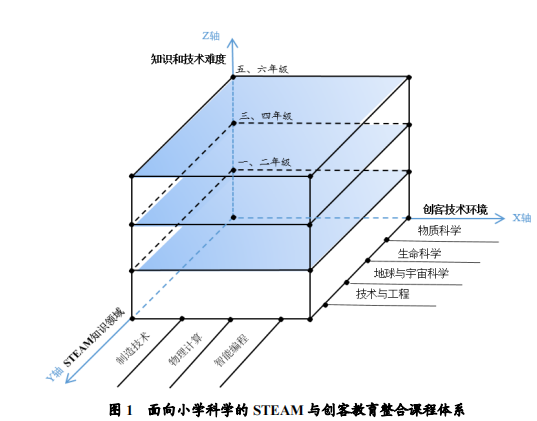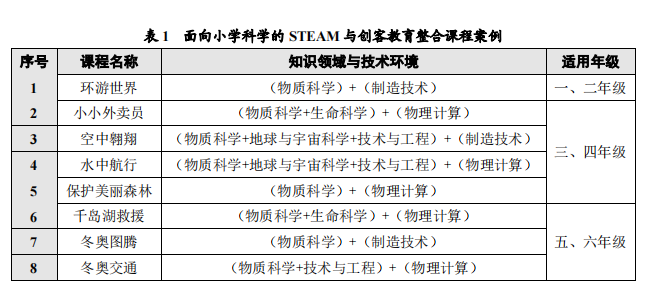This article analyzes the feasibility of integrating STEAM and maker education, using elementary school science as a starting point to construct a three-dimensional integrated curriculum system for STEAM and maker education. This system combines STEAM knowledge domains (including material science, life science, earth and space science, technology and engineering) with maker technology environments (including manufacturing technology, physical computing, and intelligent programming) in a horizontal dimension; at the same time, it integrates courses by grade levels based on knowledge and technical difficulty, reflecting the connectivity and continuity of the curriculum system. In addition, the article selects eight typical cases to analyze the practical application and effectiveness of the integrated curriculum system of STEAM and maker education. The research provides references for designing and implementing integrated curriculum systems at different educational stages and promotes further integration of STEAM and maker education.


As a new educational model, STEAM and maker education are expected to cultivate innovative and versatile talents for the 21st century, and are considered effective ways to develop students’ communication, collaboration, innovation, and critical thinking skills. In the era of educational informatization 2.0, the deep integration of information technology and education is gradually shifting from the integration of information technology with single-subject teaching to interdisciplinary teaching supported by information technology. Both STEAM and maker education feature the integration of technology and interdisciplinary teaching. Therefore, vigorously promoting STEAM and maker education is of great significance for advancing the development of interdisciplinary education supported by information technology and cultivating high-quality and competitive talents.



In recent years, STEAM and maker education in China have developed rapidly, and the corresponding technology environment has matured, but there is still a relative lack of high-quality courses and effective models, making it difficult to fully utilize the effectiveness of these technology environments. The curriculum is an important carrier for implementing STEAM and maker education; without high-quality courses, it is hard to have high-quality STEAM and maker education. This study conducted surveys on the implementation status of STEAM and maker education in Beijing, Shenzhen, Wuhan, and Cangyuan, combined with relevant literature research findings, and found that the current problems in the construction of STEAM and maker education curricula mainly include:
① Imbalance between Soft and Hard.
On one hand, STEAM courses mostly develop from comprehensive practical activities characterized by manual production, and have not yet emphasized the methods and processes of engineering practice in terms of content. Technology and engineering are inseparable from the operation and use of hardware devices and tools, but in the current STEAM course practices, technology and engineering are often weakened to simple hand-made materials such as straws, paper, and tape. Due to material limitations and manual operation errors, the products created are often rough, and once formed, they do not support multiple modifications, making continuous iteration and optimization impossible, which is an essential part of engineering practice. These phenomena expose the issues of STEAM not fully utilizing technological tools and not paying enough attention to the engineering practice process in teaching practice, which can be termed as being overly “soft”.
On the other hand, in school education, maker education is closely related to general technology education and information technology education, and due to inertia, it often focuses more on the technology environment. As a result, some maker courses emphasize teaching students the rules of programming, the use of modeling software, or methods to control robot movements, etc. However, students have little experience in integrating multidisciplinary knowledge and using technical tools to solve complex problems in real situations. Moreover, some so-called “learning by doing” maker courses often fall into the embarrassing situation of having “doing” without “learning” during implementation. Overemphasis on the coolness of technology, lack of scientific educational design, and insufficient integration of foundational subject knowledge lead maker education to become a showcase in schools, showing signs of bubble-like phenomena. The root cause of these issues lies in the fact that maker courses do not incorporate the multidisciplinary knowledge background of technology applications into their curriculum design. Problems such as a focus on hardware and software technology operations while insufficiently integrating multidisciplinary knowledge can be termed as overly “hard”.
② Absence of Standards.
Currently, there are no curriculum standards for STEAM and maker education in China. Curriculum designers often determine teaching objectives, select teaching content, and design evaluation methods based on personal concepts and experiences, resulting in courses that tend to be highly subjective and may lead to randomness in student growth and development, as well as uncertainty in learning outcomes during implementation. Additionally, due to the lack of basis or reference to relevant subject curriculum standards in course preparation, it is difficult for these courses to integrate into regular subject teaching and they become isolated from mainstream subject teaching, which is not conducive to normalized development.
③ Lack of Systematic Structure.
Currently, the common problems faced by STEAM and maker courses include: the connections between various themes or types of courses are not close, resulting in a lack of systematic knowledge structure. As noted by Yang Yanjun and others, most of the STEAM courses used or developed by schools at all levels are school-based courses, with different content, and a systematic curriculum framework that connects various educational stages has not yet formed—maker courses also face similar issues. Currently, the development of maker courses is still in the stage of autonomous actions by schools of all levels and commercial exploration by social organizations, and the lack of connectivity and continuity between various course systems may lead to overlaps or disconnections in the innovative skills and knowledge acquired by students.
Moreover, although some courses consider students’ grade levels and cognitive levels during development, the links between courses of different grades are weak, and lower-grade courses do not lay a necessary foundation for higher-grade courses. Clearly, scattered courses are difficult to continuously promote the enhancement of students’ knowledge, abilities, and qualities in teaching practice.



1.Common Goals Provide Direction for Integration
Although STEAM and maker education arise from different backgrounds and focus on different aspects, they are not entirely different educational forms, but share commonalities: both are considered effective carriers for cultivating students’ problem-solving abilities and “4C skills”, meaning they have consistency in the goals of cultivating problem-solving abilities and “4C skills”. Specifically, STEAM integrates the humanities with science and mathematics, using technology and engineering to promote problem-solving; while maker education advocates transforming creative ideas into products, which is also a problem-solving process to some extent. In terms of cultivating students’ critical thinking, communication skills, and collaboration abilities, Zhao Huiqin and others believe that maker courses developed based on the STEAM concept are important educational carriers for cultivating “4C skills”. In terms of fostering students’ innovative and creative abilities, Wang Xuqing believes that the integration of STEAM and maker education will bring new growth points for cultivating middle and primary school students’ innovative awareness and practical abilities. It can be said that under the guidance of ability-oriented goals, the direction for integrating STEAM and maker education becomes clearer and more distinct.
2. Complementary Characteristics and Advantages Promote Problem Resolution
This study believes that the integration of the interdisciplinary knowledge of STEAM and the advantages of hardware and software technology operations in maker education can effectively resolve the “soft-hard imbalance” faced during practical implementation: STEAM emphasizes interdisciplinary knowledge that can address the “hard” issues present in maker education practice, while the technical practices of maker education can resolve the “soft” issues present in STEAM practice. Regarding the potential for complementary advantages, Meng Hongjuan and others believe that the integration of STEAM and maker education can lead maker education, which is derived from general technology and information technology education, into subject teaching, achieving further interdisciplinary integration of information technology and subject teaching; on the other hand, it can provide a powerful technical lever for STEAM education, enabling it to truly realize interdisciplinary teaching in comprehensive engineering practices. Wang Xuqing believes that the digital technology and cultural atmosphere of maker education will enrich and optimize the content and methods of STEM education, while the interdisciplinary comprehensive concept of STEM education and project- or problem-based teaching methods will make maker activities more aligned with the needs of school education and talent cultivation.
3.Reference Standards Provide Effective Basis for Normalizing Implementation
The ultimate goal of integrating STEAM and maker education is to achieve their popularization and normalization in school education. In the current situation where subject-based teaching still dominates, how to integrate the STEAM and maker education integrated curriculum into subject teaching becomes a key issue—this means that the design and development of the integrated curriculum must be combined with specific subject curriculum standards. In this context, multidisciplinary curriculum standards become an important reference for the design of the integrated curriculum for STEAM and maker education, especially China’s “Compulsory Education Primary Science Curriculum Standards” and the United States’ “Next Generation Science Standards” (Next Generation Science Standards) are the most important: the former advocates interdisciplinary learning methods and suggests that teachers implement the educational philosophy of STEM in their teaching practices, giving unprecedented attention to engineering practice; while the latter clarifies expectations for learners’ academic behaviors in science education from three dimensions: scientific and engineering practices, interdisciplinary concepts, and core disciplinary knowledge. It is a summary of the long-term practice of STEM education and highlights the rich characteristics of maker education in the innovative concept of “engineering practice”. The integrated curriculum designed with reference to curriculum standards can not only supplement and expand the content and methods of subject teaching, making it easier to incorporate into the normalization of subject teaching, but also help to expand the knowledge point coverage of the integrated curriculum.



1. Proposing New Ideas for Integrated Curriculum System
To address the issues of scattered content in STEAM and maker education courses, and the lack of continuity and sustainability between courses of different grades, this study proposes constructing an integrated curriculum system for STEAM and maker education, with the following ideas:
① Ideally, the integrated curriculum should span different educational stages, solving not only the continuity and integration issues between different grades within a certain educational stage but also addressing the continuity issues between different educational stages. However, constructing a curriculum system that spans elementary, middle, and high school is a huge undertaking and too difficult, so this study temporarily focuses on building an integrated curriculum system at the elementary school stage.
② Considering that in practice, the currently experimental STEAM and maker education are difficult to normalize in core subjects such as language, mathematics, and English, but have strong operability in science subject teaching; coupled with the perspective of cultivating students’ problem-solving abilities, the STEM educational philosophy can better meet the objectives of science education. Therefore, this study takes science as the entry point for constructing the integrated curriculum system for STEAM and maker education. Ultimately, this study determines the idea of constructing an integrated curriculum system for STEAM and maker education aimed at primary school science.
2. Determining Horizontal and Vertical Dimensions
From the perspective of achieving the connectivity and continuity of the curriculum system, this study proposes to design the STEAM and maker education integrated curriculum system from horizontal and vertical dimensions:
① The horizontal dimension focuses on how to integrate the STEAM knowledge with maker technology tools within the same educational stage, which requires clarifying specific STEAM knowledge domains and typical maker technology environments to form a planar and intersecting curriculum network, enabling students at the same educational stage to better learn STEAM knowledge using maker technology tools.
② The vertical dimension focuses on how to achieve the spiral advancement of integrated curriculum content in knowledge and technical levels according to the psychological characteristics of students in different grades, especially their cognitive characteristics. This requires referencing the difficulty levels of subject curriculum standards and maker technology tools, designing the content of the integrated curriculum in a progressive manner, allowing students of different grades to continuously and progressively learn multidisciplinary knowledge and master the relevant operational skills of maker technology tools.
3.Designing the Integrated Curriculum System
Based on the aforementioned ideas for the STEAM and maker education integrated curriculum system, this study designs the STEAM and maker education integrated curriculum system aimed at primary school science from horizontal and vertical dimensions.
(1) Clarifying the Integrated Knowledge Domains and Technical Environments
In terms of STEAM knowledge domains, this study refers to the “Compulsory Education Primary Science Curriculum Standards” issued by the Ministry of Education in 2017, dividing scientific content into four major fields: material science, life science, earth and space science, technology and engineering. In terms of maker technology environments, this study categorizes typical maker technology environments into three types based on the views of Martinez and others:
① Manufacturing Technology (Fabrication), which allows students to design and build real-world material objects; in the practice of maker education, 3D printing and laser cutting are typical representatives.
② Physical Computing (Physical Computing), which is a system that perceives and interacts with the real world through hardware and software; in the practice of maker education, there are programmable robots, Raspberry Pi, Arduino, micro:bit, and control boards.
③ Intelligent Programming (Programming), which externalizes abstract thinking through programming to help students learn; in the practice of maker education, there are programming languages such as Logo, C++, Java, Python, and Kitten. The difference between intelligent programming and physical computing mainly lies in that intelligent programming is an environment that does not require external electronic devices, and the form of the work is small games or animations; while physical computing interacts through programming and external electronic devices, requiring connections to electronic hardware, robots, and other external devices.
(2) Clarifying the Principles of Integration
As mentioned earlier, integration mainly refers to the integration of STEAM knowledge domains and maker technology environments. Accordingly, this study establishes the principle of integration: integrated courses must simultaneously contain elements from both the STEAM side and the maker side, without limiting how many types of elements each side contains. For example, an integrated course can be an integration of one knowledge domain from the STEAM side and one type of technology environment from the maker side, or an integration of three knowledge domains from the STEAM side and two types of technology environments from the maker side. Based on this principle, this study randomly combined the four knowledge domains from the STEAM side with the three types of technology environments from the maker side, resulting in a total of 105 combinations according to the calculation method shown in formula (1).

It should be noted that these 105 combinations are just a large classification framework of combinations, and the actual number of combinations is far greater than this. In terms of maker technology environments, each category also includes various specific technology types, such as manufacturing technology, which includes 3D printing, laser cutting, etc. Additionally, interdisciplinary content is not limited to the four knowledge domains in science; knowledge from other subjects in the same grade, such as mathematics, information technology, and general technology, also needs to be considered, but they are not used as the basis for this study’s knowledge domain classification.
(3) Adding Grade Levels Based on Integration
This study uses the X-axis to represent maker technology environments, with manufacturing technology, physical computing, and intelligent programming represented by coordinates on the X-axis; the Y-axis represents STEAM knowledge domains, with material science, life science, earth and space science, technology and engineering represented by coordinates on the Y-axis. The plane formed by the combination of the X-axis and Y-axis represents the integration of curriculum knowledge domains and technology environments in the horizontal dimension. Based on this, this study adds grade levels and uses the Z-axis to represent knowledge and technical difficulty, with three grade levels represented by coordinates on the Z-axis, achieving vertical integration of the curriculum. Thus, this study constructs a three-dimensional integrated curriculum system for primary school science aimed at STEAM and maker education, as shown in Figure 1.

Considering the varying levels of knowledge and technical difficulty across different grades, this study divides the six grades of primary school into three grade bands: grades one and two as lower grades, grades three and four as middle grades, and grades five and six as upper grades. As shown in Figure 1, as the grade band increases, the knowledge and technical difficulty also increase. Regarding the basis for upgrading, the knowledge difficulty upgrade mainly refers to China’s “Compulsory Education Primary Science Curriculum Standards” and the United States’ “Next Generation Science Standards”, both of which arrange corresponding knowledge content for different grades based on the cognitive characteristics of students at different ages and the position of each knowledge point in the subject knowledge system. For the technical difficulty upgrade, there are currently no relevant technical standards for reference, but it can be corresponded to different grade bands based on the ease of learning and using the technology: easy-to-learn and operate technologies correspond to lower grades, technologies with certain difficulty in both learning and operation correspond to middle grades, and technologies that are difficult to learn and operate correspond to upper grades. For example, in manufacturing technology, 3D printing can be implemented in two ways: one is to use a printing pen, which is similar to drawing with a colored pen, where what is drawn is what is obtained, very intuitive and easy to operate, so the learning and expanding technical content is limited and can be used for lower grades; the other is to first model using modeling software and then print, which requires students to have a certain foundation in computer software operation and spatial imagination skills, and mastering various operations of modeling software requires extensive learning, thus allowing for a rich expansion of content, suitable for upper-grade teaching. It should be noted that the learning and use of each maker education technology environment must consider the students’ existing prior knowledge level, progressing gradually from easy to difficult.



This study uses a series of STEM courses aimed at promoting core competencies as case sources, selecting eight representative integrated curriculum cases for primary school science in STEAM and maker education (the textbooks containing these eight cases have been published by Hubei Science and Technology Press), as shown in Table 1. Among these eight cases, one is suitable for grades one and two, four are suitable for grades three and four, and three are suitable for grades five and six; the content areas of the courses mainly focus on material science, and the types of technology environments mainly involve physical computing.

Specifically, the above eight cases mainly target middle and upper primary school grades, each course balances knowledge foundations and technical practices, and the course content is innovatively compiled and presented based on topics, integrating teaching design, student learning plans, evaluation exercises, etc., facilitating teachers’ lesson preparation and student guidance. In addition to developing printed course textbooks, the research team also developed corresponding online course resources, which can dynamically present the operational processes of hands-on experiments, making it easier for students to learn and understand. Accordingly, the teaching methods include localized teaching and the “three classrooms” (i.e., remote dual-teacher collaborative teaching + special teacher delivery teaching). Furthermore, to help teachers quickly familiarize themselves with the teaching content and methods of the integrated curriculum, the research team has developed supporting teacher manuals for each course, detailing the design intentions of the curriculum system and activities, and providing relevant activity organization suggestions to guide teachers in adapting to and implementing the courses. Currently, these eight case courses have been implemented in schools in Beijing, Shenzhen, Wuhan, and Cangyuan. Through informal teacher-student exchanges and classroom observations, this study found that the learning content of these eight case courses is rich, and the activity design is interesting, receiving positive feedback from both teachers and students, especially students, who have shown high interest and enthusiasm for the course content.



The integrated curriculum system proposed in this study for STEAM and maker education covers all stages of elementary school, providing references for the implementation of integrated curricula at the elementary level, as well as guidance for the design of integrated curriculum systems at the middle and high school levels. The STEAM and maker integrated curriculum system, which integrates STEAM knowledge domains and maker technology environments, helps to resolve the issue of STEAM focusing on multidisciplinary knowledge transmission while neglecting engineering practice, and maker education focusing on technical operations while ignoring foundational subject knowledge. In addition, the STEAM and maker education integrated curriculum system is designed with reference to relevant curriculum standards and by grade levels, containing both horizontal and vertical dimensions and three axes (X, Y, and Z), reflecting the connectivity and continuity of the curriculum system, and providing a guiding framework for knowledge and technical integration along with a systematic method for curriculum construction. However, the practical application of the STEAM and maker education integrated curriculum system has just begun, and large-scale, standardized evaluation of the implementation effects has not yet been conducted. Therefore, the next step in the research will be to conduct systematic evaluation work to measure students’ academic performance, problem-solving abilities, and “4C skills”; at the same time, interviews and qualitative analysis will be used to collect feedback from teachers and students, collaboratively promoting the deep integration and implementation of STEAM and maker education curricula from three aspects: curriculum design, teaching support, and learning assessment.